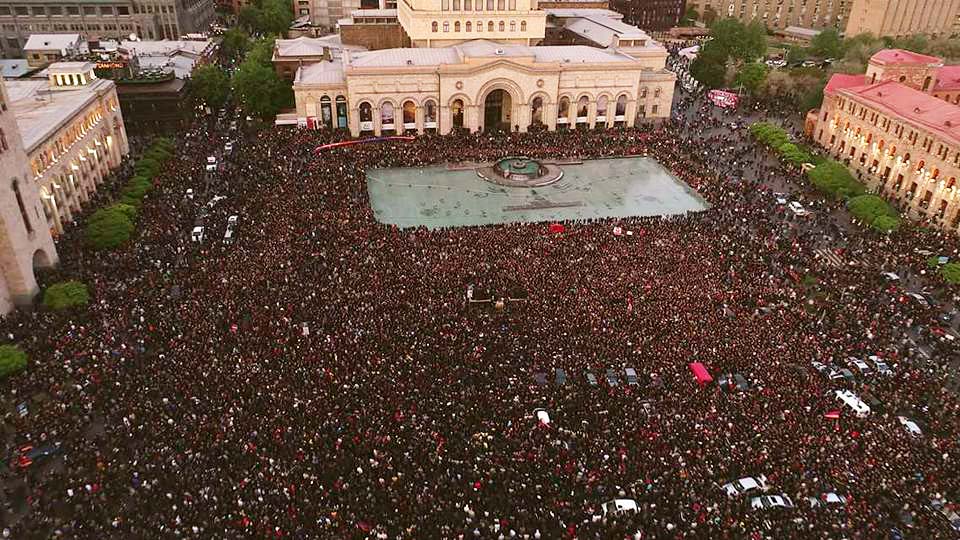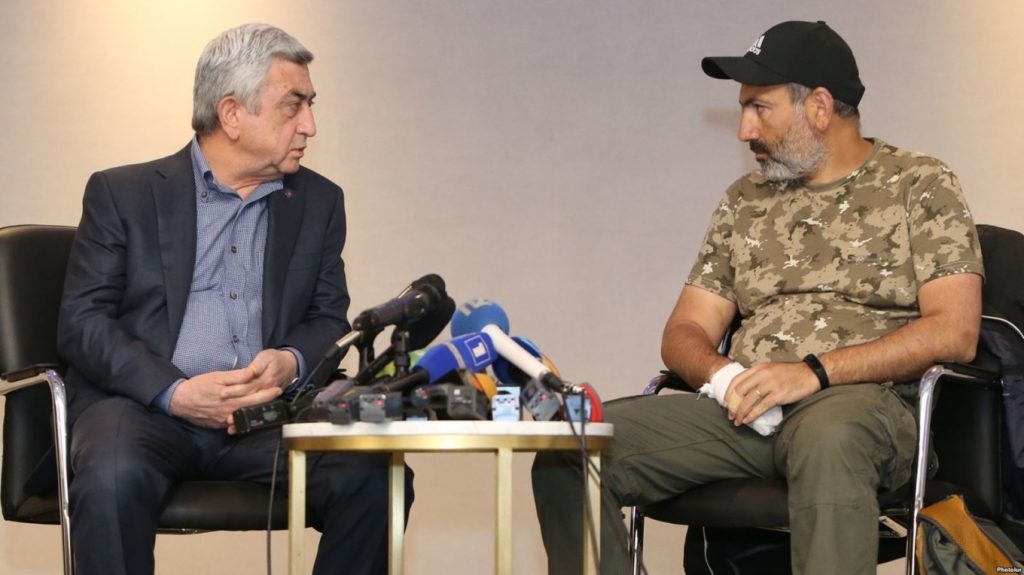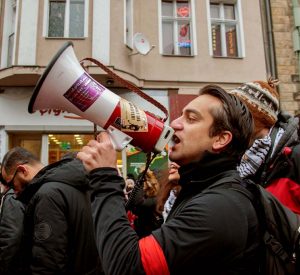
A mass movement in Armenia pushed out the Prime Minister and former president Serj Sargsyan. Even if liberal currents are trying to channel the movement and gain electoral support, this event could also be a positive move for the oppressed youth and the working class in the country. We interviewed Hovhannes Gevorkian, an Armenian student of Law in Berlin and member of the Revolutionären Internationalistischen Organisation (RIO) of Germany. The interview was conducted by Philippe Alcoy (PA).
PA: How did the movement start? Is it the first time that people demonstrate against the government?
The movement started at 13th of April when the first actions of civil disobedience began. Prior to that, opposition leader Nikol Paschinyan made a protest walk through Armenia. Back in the capital, Yerevan, the opposition began with protests against the election of former President Serj Sargsyan as Prime Minister scheduled in a parliamentary vote on 17th April. It was the youth who started to block the streets with peaceful means as they didn’t want the election to take place. Students tried to occupy the university but the police forces were too strong. With the help of massive police force, the protesting masses couldn’t prevent the vote in the parliament but the protests grew bigger and bigger, nevertheless.
Armenia is a country that has always had big economic problems together with a corrupt political class, and also has a history of protest. In 2008, people protested against the fraudulent election of Serj Sargsyan as President. At its peak, over 150,000 demonstrated in Yerevan. Back then, the struggles were much more violent and on the 1st of March of that year the repressive forces (including Russian special forces) shot at the protestors with live ammunition. At these events — in Armenia simply referred as “1st March” — ten people died.
Another interesting movement was the largely youth protest against the hike of electricity prices in 2015. At that time, people also blocked and occupied streets and places. This protest was peaceful but showed once again the dissatisfaction with the government and the ruling Armenian Republican Party (ARP).
What are the social forces driving the movement?
Clearly the youth, but also women, who take a large part in the protest, although unfortunately with weaker representation. The students are very active and a bastion of the movement. It’s my generation, born after the collapse of the USSR and only knowing the bourgeois republic. It’s the generation who has no prospects in the country, the generation who is leaving the country whether to study or to work in other countries.
But we also have to take into account that, due to the hatred against the oligarchs, other parts of the population are taking part. It’s a mass movement the country never has seen before.
There are liberal political forces in the movement, what is their real influence?

They have a big influence, as the charismatic leader of the movement is Nikol Paschinyan, who is himself a liberal. You may have heard his name for the first time in the recent days but he’s not an unknown political figure in Armenia. Basically, he is a pupil of former and first President Levon Ter-Petrosyan, who ruled the country from 1991 to 1998. Ter-Petrosyan was responsible for all the privatisations of industry and the rapid rise of the oligarchs. He himself had to step down because of mass protests in 1998, as he was willing to negotiate with Azerbaijan over a possible Armenian retreat from Nagorno-Karabakh.
In 2008 it was once again Ter-Petrosyan who challenged Serj Sargsyan in the presidental elections. After the 1st of March and the imposition of the state of emergency (with a ban of strikes, demonstrations, media censorship and much more) Ter-Petrosyan was put under house arrest. Through all that, Nikol Paschinyan was his protege. In 2008 he had a much more militant agenda: “We will fight until the end!”. Nikol and the other leaders of the opposition had to hide until they turned themselves to the police in June 2009. Nikol was then accused of murder and mass disorder. He would spend the next two years in prison.
Since then, he has learned a lot. Over are the days of the serious politician Nikol Paschinyan, who was just dressed just like others politicians. Nowadays you see him as an activist, marching all the day with a megaphone through the streets. His political agenda remained nearly the same, as he is a liberal and a MP for the liberal coalition ”Yelk”. It’s a formation of petty bourgeois businessmen but Nikol is able to represent himself as an activist just like the students.
Because it’s a democratic movement, his demands are for free and fair elections, and his rejection of Serj and his party, he is very popular. He’s always addressing the people and tries to present himself as transparent and anti-corrupt. In this regard he is very open and always calls for open talks. That’s also the reason why we saw public talks with him and Serj or President Armen Sargsyan.
What is the situation of the working class and of the youth in Armenia today?
Both live under terrible conditions. The official unemployment rate is 20 per cent; jobs are rare. There is no prospect for the youth because the economy in Armenia is very bad. There are many poor people in Armenia who are suffering, as industry was almost completely destroyed in the 90s. Armenia as a former Soviet Republic had a working class which was well organized and had trade unions. The trade unions still exist but they are very weak and the working class is fragmented.
Nevertheless we have also seen during the political protests strikes at the IT-company Synopsys and the big shopping mall Dalma. In both cases, the workers went on strike and joined the street blockades. The students are well organized and also went on strike. Interestingly Nikol called on the 25th of April for a nationwide labour and student strike, which then didn’t take place because the interim government announced that new elections will be held on 1st of May.
So the prime minister resigned but the movement continues. What are the prospects for it?
The people know that the problem wasn’t just Serj. He himself had a scandalous luxurious life and it was clear that the people hated him. But they also know that he and his party represent the oligarchs. The movement continues and the slogans go on from #RejectSerj to #RejectHHK (Armenian abbreviation for ARP). In very poor semi-colonies like Armenia the democratic movement always has social demands because people not only want to have free elections but also work, higher rents, bread. Earlier this year we saw something similar in our neighbor country Iran.
Now everybody is preparing for the Parliementary elections. It’s possible that other bourgeois parties like Tsarukyan (founded and led by oligarch Gagik Tsarukyan) will support Paschinyan. He himself announced that he and Yelk will take part in the elections. That’s also the reason why now the mobilizations and acts of civil disobedience have stopped. They will now go to the other cities and do their election campaign. Paschinyan has a chance to win but it’s not sure. He is very popular at the moment.
It will be very interesting to see how the elections will go, whether there will be corruption and fraud or not. It seems likely because the whole state apparatus in under the control of the ARP. This party functions also like a mafia body, which is also determined to use criminal methods in order to secure their rule.
Do you want to add something?
I think the mass protests in Armenia with the victory over Serj Sargsyan open a new chapter in the Near and Middle East. In recent years we saw mass protests in Kurdistan, Iran and now in Armenia. In a region that’s very explosive and fragile, the Armenian “Velvet Revolution” (as it is called by Paschinyan and his supporters) showed that victory is possible. We haven’t seen that since the Arab Spring with the overthrow of Ben Ali and Husni Mubarak in Tunisia and Egypt. Since then we also saw that the overthrow of one ruler is not enough and the masses in Armenia will have the same experience.
I do not consider the recent events in Armenia as a revolution because the old capitalist class is still exploiting the country and the working class. There is also no revolutionary party in Armenia — but experiences like this help us to build revolutionary organizations. Victories like this enhance the class consciousness of the protestors. The youth, who made this victory possible, will remember their strength. Other oppressed and exploited masses like the Kurdish people, the Iranian working class but also the sisters and brothers of the Azerbaijani and Georgian working classes will learn from the mass protests. They will, together with the Armenian masses, see that total victory is only possible on an international level.
 Hovhannes Gevorkian was born and lived in Yerevan, with much of his family coming from Western Armenia. He is now a student of Law in Berlin and member of Revolutionären Internationalistischen Organisation (RIO) of Germany.
Hovhannes Gevorkian was born and lived in Yerevan, with much of his family coming from Western Armenia. He is now a student of Law in Berlin and member of Revolutionären Internationalistischen Organisation (RIO) of Germany.

